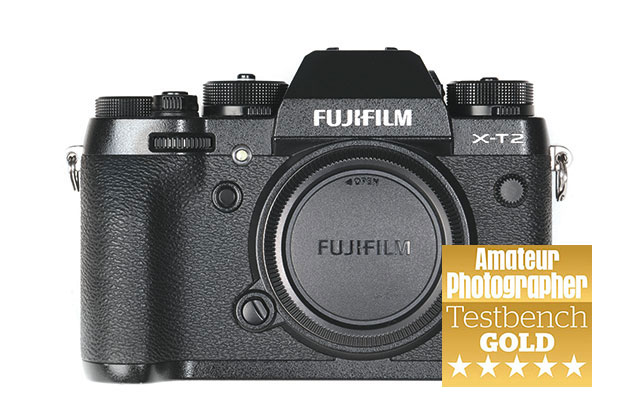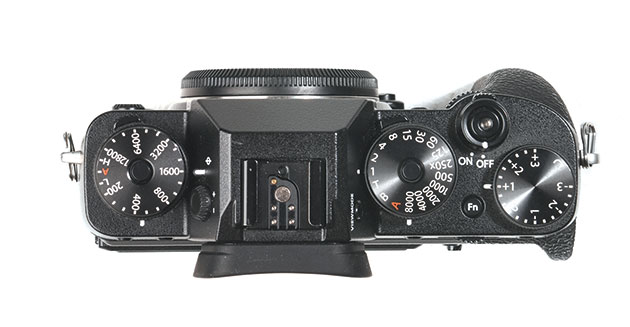
The design of the X-T2 shares much of a likeness to the X-T1. It has an intuitive layout of buttons and dials, and benefits from an AF joystick at the rear
It’s hard to call the X-T2 a classic when it’s only three years old; however it’s a camera that’s become so popular since its release in July 2016 we have no doubt it’ll be a classic in the future. The X-T2 is in keeping with the shape and style of a DSLR, with the blend of well-sculpted handgrip, central EVF and classic arrangement of buttons and dials making DSLR users feel right at home. At its heart it has a 24.3MP X-Trans CMOS III sensor that presents an ISO range of 200-6400 (expandable to ISO 100-25,600). Other features include its 2.36-million-dot EVF, up to14fps continuous shooting with a booster grip, 325-point AF system, three-way tilting screen and 4K 30fps video.
Fujifilm X-T2 at a glance:
- £519 body only (via mpb.com)
- 24.3MPAPS-CX-TransCMOSsensor
- ISO 100-51,200 (extended)
- Dual SD card slots
- Up to 14fps continuous shooting
- 507g (with battery and card)
For and against
+ Fantastic autofocus response
+ Renders rich, vibrant colours
+ Classic and nostalgic retro charm
– Camera battery can’t be charged via VPB-XT2 power booster
– Lacks touchscreen control
– No 4K 60p 4:2:2 video recording

Its three-way tilt screen makes low- and high-angle shooting in the portrait orientation much easier
What we said
- ‘Fujifilm has taken feedback from the X-T1 onboard and ensured the X-T2 isn’t a minor update on what we’ve seen before but a revolutionary one’
- ‘Its agile AF response is in a different league to the X-T1’
- ‘It’s the most appealing model in the X series to date and will change people’s perception of speed associated with mirrorless cameras’
- ‘The booster grip is essential for high-speed burst at 14fps’
What to pay
MPB.com had many of these in stock at the time of writing, ranging from excellent to like-new condition. The cheapest was being sold for £519 in excellent condition. You’ll find that like-new examples of the X-T2 fetch around £544. Graphite edition X-T2s cost more (£664 for one in like-new condition). Used examples of the VPB-XT2 vertical grip can also be picked up quite reasonably from £84.
How it fares today
It can’t shoot up to 30fps, but 14fps with the power booster is more than adequate for most. Its AF system keeps up with fast or erratic subjects and the general feel and handling is terrific. Face detection and eye detection are both present, but the X-T3 has improved greatly in these areas. Those serious about video may findtheX-T2’slackof4K/60p 4:2:2 10-bit HDMI output a reason to choose the X-T3.
New alternatives
The X-T2 was replaced by the X-T3 last year. It shoots as fast as 30fps (with a 1.25x crop of the sensor), has a 3.69-million- dot EVF, introduces touch control on its 3in, 1.04-million- dot screen and offers broadcast- quality 4K/60p 4:2:2 10-bit HDMI output. There’s plenty more besides. It has four times as many phase-detection pixels on the sensor, plus the low-light sensitivity goes down to -3EV.
What the owners think
Three Fujifilm X-T2 users give their verdict

The unmistakable roof at London King’s Cross station. Fujifilm X-T2, Fujinon XF 10-24mm F4 R OIS, 1/125sec at f/5.6, ISO 640. Credit: Andy Parslow
Andy Parslow
I upgraded to an X-T2 from my X-T1 around two years ago. The jump in image quality and ISO capability was an instant improvement. I rarely use autofocus for my photography, but it is very quick and having such advanced tracking options available should you need them are great to have. My main interests are street architecture and family documentary photography, so I have built up a range of Fujifilm lenses and also some manual focus third-party lenses. When I use the latter, the X-T2’s excellent focus peaking helps enormously.
Another major plus is the dual card slot arrangement that serves as either a second backup, sequential storage or raw and JPEG separation. The film simulations for JPEGs are seriously good, and as a predominantly black & white photographer, I leave the camera set to shooting in the superb Acros simulation mode most of the time. The X-T2 would suit whatever style of photography you’re into and with the launch of the XT-3 (which I’ve not felt the need to upgrade to yet) it’s possible to pick up a great deal on a used example.
For and against
+ Weather-sealed
+ Excellent image quality at high ISO
– No touchscreen
– Genuine spare batteries are expensive

This composite was created from two separate X-T2 images. Fujifilm X-T2, Fujifilm XF 18-135mm F3.5-5.6R WR OIS. Credit: Paul Parkinson
Paul Parkinson
The X-T2 was the camera that made me switch from Canon to Fujifilm. I’d previously bought an X100T and fell in love with it; then after trying the X-T2, decided my future would be with Fujifilm. There’s a lot to be said for owning a camera that just feels right in the hand. What I love about the X-T2 is that the buttons fall nicely under your fingers and the dials are just where you want them. I have fairly big hands so I also purchased the optional metal handgrip (MHG- XT2), which costs £100. Once this was in place the X-T2 felt even better and it allows you to access the battery and SD card slot without having to remove it. One slight niggle with the X-T2 (and the X-T3 and X-H1) is that certain menu functions are not remembered when you power down and turn it on again. One such example is the self-timer.
For and against
+ MHG-XT2 improves the handling
+ Exposure compensation control
– Certain functions are not remembered when it’s switched off

Sunset at Saltwick Bay on the North Yorkshire coast. Fujifilm X-T2, Fujinon XF 10-24mm F4 R OIS, 1/4sec at f/11, ISO 200. Credit: Mark Heslington
Mark Heslington
I’d heard great things about the Fujifilm system so decided to take a closer look. I bought the X-T2 in used condition in late 2018, along with the 18-55mm f/2.8-4 kit lens. The menu system is easy to understand so whatever system you are coming from you will have no problems in mastering this camera. For photographers who shoot JPEG, the way Fujifilm renders colour in its images is beautiful, and unique. Shooting at higher ISO is not a problem as any noise appears more as grain and only adds to the image. Fujifilm as a company listens to its users and regularly releases firmware updates that improve the functionality of their camera system. My move to experiment with a mirrorless system was driven by a desire to lighten my load and the Fujifilm X system delivers this without compromise.
For and against
+ Great range of relatively affordable Fujifilm lenses
+ Film simulations
– Not all fast Fujifilm lenses are light









